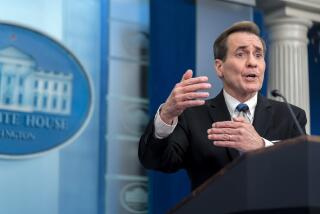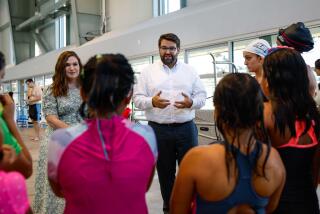THE MOSCOW SUMMIT : U.S. Government Run From Soviet Capital : 5,000 Miles From Potomac, White House Is in Business
MOSCOW — Dial a seven-digit telephone number in Moscow and a distinctly American voice, exuding calm authority, answers after one, two, no more than three rings: “Moscow White House.”
Welcome to Washington-on-the-banks-of-the-Moskva.
As it is everywhere the President travels, so here 5,000 miles from the Potomac a miniature White House has been established--albeit scattered across the downtown area of the Soviet capital, in the U.S. Embassy, the ambassador’s residence and a modern hotel overlooking the meandering Moscow River.
According to White House officials, the temporary headquarters provides President Reagan and his senior assistants with all the facilities needed to run the U.S. government during their visit here.
All it takes is about 700 people, a couple of months of preparations, some discipline to remember that few rooms are secure from eavesdroppers, and enough American doughnuts.
Intelligence Briefings
Bills have been signed. Intelligence briefings have been delivered. A 9 a.m. meeting that takes place daily in the Oval Office when the President is at the White House is being convened at the same hour this week in Spaso House, the residence of U.S. Ambassador Jack F. Matlock Jr., where the President’s quarters have been established.
And just as in Washington or at Camp David or the Santa Barbara ranch, or anywhere else he goes, Reagan is accompanied everywhere in Moscow by a military officer carrying a soft black leather briefcase known as “the football.”
It contains the ultra-secret codes and other material necessary for the President to transmit launch orders for U.S. nuclear missiles and bombers.
On Tuesday, when Reagan strolled across Red Square and toured the plaza inside the Kremlin walls, the football was always right behind him.
Before leaving Washington last week, White House officials sought to clear up as much business as possible, so Reagan would be able to concentrate on his summit meetings with Soviet leader Mikhail S. Gorbachev. To a large extent, they say, they have been successful.
Daily Operations
Still, the daily functioning of the White House operation must continue, summit or not.
The President’s daily national security briefing, prepared by the CIA and the Defense Intelligence Agency, is transmitted to Moscow from Washington each day of the President’s visit, giving him an update on developments around the globe.
The written summaries are transmitted on a data channel “which we are confident is secure--we’ve double-checked it,” a senior White House official said.
In Moscow, where a year ago American experts found that a new embassy building was bugged top to bottom even before construction was completed, security for the President and his top aides was a special problem.
Just a short walk from the embassy is a church that U.S. officials fear is a center of intelligence gathering. It is known among resident Americans as “Our Lady of Telemetry.”
Shielded Conversations
With such concerns in mind, two recreational vehicles, specially shielded to keep sensitive conversations inside, have been parked in the embassy garage, for use by Secretary of State George P. Shultz, Defense Secretary Frank C. Carlucci and Lt. Gen. Colin L. Powell, the President’s national security adviser. One was installed for secure conversations, including those on telephones, and one to receive and send secure data transmissions.
As rooms in the old embassy and in Spaso House were swept by counterintelligence specialists for eavesdropping devices, U.S. Marines brought in to augment the usual embassy detachment were stationed in each.
Signs were posted everywhere the American summit party would be stationed--in hotel rooms, corridors and temporary offices--reminding White House staff members: “This area is not safe for sensitive conversations or reading of classified material.”
The White House Communications Agency, a branch of the U.S. Army Signal Corps, sent in a large but undisclosed number of soldiers to establish a special communications center for the visit.
Much of the gear for the visit--including even the President’s armored Cadillac limousine, a spare limo and a Secret Service follow-up van--was flown in on C-5A Air Force transports, the largest airplanes in the West.
Crockery and Light Bulbs
The special airlift aboard the C-5As also brought equipment and supplies--everything from photocopiers to desks, from crockery to light bulbs--that U.S. officials feared would be difficult to obtain from commercial sources in the Soviet Union or might not be reliable.
For the Tuesday night dinner that the President and First Lady Nancy Reagan gave at Spaso House for Soviet leader Mikhail S. Gorbachev and his wife, Raisa, all the food--the lobster bisque, the sesame sticks, the supreme of chicken with truffle sauce, on to the frozen chocolate mousse with vanilla sauce--was flown in from the United States.
And so were the doughnuts, ham-and-cheese and turkey-and-cheese sandwiches served in the mini-White House mess set up for staff members staying at the Mezhdunarodnaya Hotel.
So too the toilet paper, drinking water and facial tissues supplied to the traveling White House staff.
No White House Motor Pool
But there are differences:
The White House motor pool, with its shiny sedans and U.S. Army drivers, stayed home.
With the exception of the President and a few others, “we all have to use Russian drivers. They don’t speak a word of English--that I know of,” said a senior official.
Are the cars comfortable?
“Not particularly. They’re a low-rent model,” he said.
Then there is the matter of that longtime Washington pastime: gossip.
For fear of being overheard not by their colleagues but by Soviet eavesdroppers, White House staff members say they are trying to lay off their normal pattern of in-house gossip. There’s no point, they say, in telling tales that could eventually be used to blackmail one of their number.
More to Read
Sign up for Essential California
The most important California stories and recommendations in your inbox every morning.
You may occasionally receive promotional content from the Los Angeles Times.










